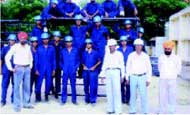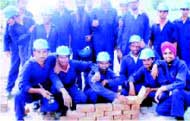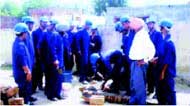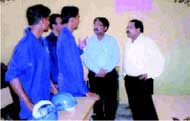Need of the Day: Re-engineering Skills and not Layoffs

What has been the impact of the liquidity crunch on the construction and infrastructure sector? What needs to be done so that the present sluggish pace in the sector picks up sooner rather than later? Will the new fiscal packages as announced help? How and where from funds of this magnitude are going to be mobilized and the evolving situation managed to sustain the tempo of growth attained so far?
The first half of the financial year 2008–09, continued with the usual growth trend, however the second half displayed rather slow performance. One of the major reasons for this reversal in the growth pattern was the liquidity crunch.
The housing and real estate sector and also those where private partnership played a predominant role are the most affected ones.
Arrest and reversal of the ongoing trends is the first and foremost action which needs to be taken by the Government at all three levels, Central, State, and Local.
Whereas confidence-building measures such as enhancing liquidity in the market and lowering the interest rates can help overcome small spikes, long–term and sustainable, set initiatives should be taken without delay.
Such initiatives should be driven by the following axioms.
Project Formulation and Implementation, Enhance Public Spending in developing Physical Infrastructure. Prioritize the programmes. Ensure that the procurement process is equitable and disputes are resolved expeditiously. Stop the non– performing projects.
Institutional Financing ensure that the execution risk identification, profiling, and mitigation is done scientifically and realistically. For critical projects, such as transportation networks create solatium funds and insurance products to make them more bankable. Formulate a firm national policy for construction financing.
I have spoken about the short- term impact of the fiscal measures introduced by the Government, and strongly recommend that these need to be supplemented with the measures, suggested above, failing which the possibilities of economic revival are remote.
I do not subscribe to the view that there is paucity of funds and finances to undertake such initiative. The problem lies in the way we spend money.
Of every 100 Rupees spent, almost 40 Rupees are blown away, because the public procurement systems are cumbersome and have little objectivity. Time and cost overrun in project execution is a rule rather than exception. Systems, we use are based more on cliché’s, rather than the purpose.
As an example, I would say that the cost of procuring, the procurement agency itself works out to 8-10% of the cost of the project the solution lies in eliminating such archaic and frivolous procedures.
Please tell us something about CIDC, and its evolution so far, focused areas of operation, its milestone achievement in fine-tuningprogrammes resulting in benefits to the construction industry in India, in sharp contrast to the past practices.

Apart from the four major works ministries of the Central government, (Defence, Urban Affairs, Surface Transport, and Railways) several PSUs, Academic institutions, Industry Constituents, and Industry Associations are the constituents of CIDC and are well represented on the Governing Board.
The guiding spirit of CIDC is to protect, project and promote construction industry and act as an interface between the Government and industry.
Since inception, CIDC has been successfully evolving and formulating policies and also implementing them in association with all stakeholders. Some of the major initiatives are: Development of national plans, streamlining the procurement practices, development of human resources, Evolution of economic parameters, conducting studies and research, establishing risk assessment and mitigation products, establishing dispute resolution institutions, facilitating establishment of a construction equipment Bank and many more.
All the initiatives have been successfully implemented and have been able to bring in a substantial change in the way construction industry functions today.
A major change agent has been the HRD initiative by CIDC. Over 300,000 persons and several construction companies have benefited, through this initiative.
Spectre of manpower crunch is looming large over all industry, including the construction industry. What needs to be done at the national and specific industry level to offset the shortage of new talent and trained manpower, and can you comment on the pioneering role CIDC has been playing with its innovative training modules in upgrading the professional skill and expertise of personnel for the construction industry?

Over 31 million citizens find direct employment in the industry through the secondary, supporting sector. Construction, being the largest user of several core sector Industrial products, such as steel, cement, paints, tiles, glass, and chemicals determines the fortune of the manufacturing sector. It is therefore, vital necessity that the national focus, be on human resource development. Looking at the present scenario, the crunch being felt is of qualified, competent and trained personnel.
Identifying this crying need, and also keeping in view the non- availability of training and skill development infrastructure, CIDC joined hands with several universities, boards of technical education, and industry to launch a National Skill Development Initiative in 1998. The need of joining hands with Universities / BOTE and Industry was to evolve.
- A workable pedagogy
- Training contents to suit the needs of employers
- Provision of continued education and continuous skill upgrades
The solutions came from the combined support of the industry constituents and several state governments who provided the infrastructure and related support to CIDC.
As regards the trainers, CIDC designated one of the Institutes at Palwal, Haryana as the Trainers Training Institute.
Apart from training the artisans, other short and long duration training programmes leading to the certificate courses for supervisory cadre persons and aspirants of Diploma in Engineering Programes were also launched, which are progressing very well.
For upgrading the skills of mid and higher level engineering and managerial personnel, almost 30 Executive Development Programmes, covering various aspects of the construction business are now being offered annually.
The overall impact, as has been observed, so far, is extremely positive, and has enabled the Construction Industry to improve the performance.
Recently, CIDC has taken a new initiative to train and upgrade the skill of personnel in material and equipment companies as reguested by them. It would be of great interest to our readers if this new initiative iselaborated. What has been the feedback and how this programme is proposed to be expanded further to cover other segments of the industry? It is really a paradox that at customer and user ends, due to lack of training, equipment and facilities are not utilized as per their potential.
It is interesting to note the general perception about the construction industry, remains limited to the construction companies. The truth is far from it. The industry includes the material and equipment manufacturers, and service providers of various specialities. For example, the cement manufacturing industry is 100% dependent on construction activities, and so are hosts of others.
Looking at the HR needs of such enterprises, one can say with certainity that the skill impartation and upgradation needs are very similar to those in the construction industry, along with an added requirement. This is to understand the construction industry.
Recognizing this need, CIDC, has for past three years, been interacting with several manufacturing enterprises to help them meet their HR requirements.
The essential needs of this construction industry manufacturing sector as analysed and observed are as follows:
- Have well trained operators and maintenance personnel for the equipment being manufactured.
- Have good and knowledgeable applicators of the products.
- Have good sales persons, who understand the work dynamics of the construction industry.
To address this need, several programmes have now been launched, where the beneficiaries are Escorts Construction Equipment Ltd., Mittal, HMEL, Reliance Industries Ltd, Universal Ltd, and others. One needs to remember that a manufactured product is only as good as the operating person. The response has been very good, and this is expanding to cover many other enterprises, to enable them to offer value added support to construction companies who are their clients.
Apart from the manpower crunch, what are the other issues confronting infrastructure development in the country, which is both the cause and effect of economic growth. Based on CIDC experience of studying projects in India and abroad, how acute is the problemrelating to project planning and implementation in other countries, and what needs to be done in our context to speed up project implementation for country’s inclusive growth?

Unfortunately, these are very frequent casualty. As very soft traits, they are person centric and once again training the human mind is of paramount importance.
There is a general perception that using the available computer aided tools- one can plan and schedule effectively. Unfortunately, one does not realize that it is the human prowess that ultimately will drive and run computer programmes as well. There are plenty of tools available in the market that can effectively be used; however, one needs to use them, incorporating the real life experiences.
Speaking about planning of the project at national level, one also needs to look at the overall benefit which can be derived out of the executed projects.
Unfortunately, the ground realities are quite contrary and in many cases the decisions are based on the exigencies other than the overall benefit motive.
CIDC conducts several conferences every year to impress the national and industry leaders about such issues and also conveys the message through national Plans and reports of various task forces on which CIDC serves.
The task is rather gigantic and therefore a continuous national debate must take place where these issues have to be highlighted time and again for a sustained effect.
The market today is begging for qualified and trained manpower, particularly in civil engineering. Why are our institutes of higher education like IITs, IIMs and AICTE failed to respond to market signals? While some of these institutes continue to flourish, their products, barring those from IITs and IIMs, have failed to bear the weight of emerging market expectations. Simultaneously, the mind set of roughly 3 million new graduates passing out every year and showing preference for a few MNCs and bigger companies rather than opting for small and medium businesses,needs to be changed. How can this be sensitized at the national level to remove present day distortion in the employment market?

As regards, the institutions of excellence and other Institutions mentioned by you, all I can say is that the syllabi adopted by them has little bearing and consonance with the needs of employability. Further, there is a great need for teacher’s education as well. Many of the teaching staff lack hands-on experience and the situation needs to be remedied. CIDC is therefore, introducing many bridging programs to overcome this shortcoming.
Ironically,while the industry complains about the manpower crunch, it is subsisting short term, quickfix solutions to lay off personnel to cut its operating costs as fast as possible. What suggestions you would like to offer to such entitiesthatinstead of focusing on layoff alone, they keep a sharp focus on their area strength, imparting new knowledge, expertise and skill to their manpowerin seeing the company forwardthrough recessionand learn how to manage down turns. This could indeed be their inclusive USPin the coming days compared to what they had in the past.
You are absolutely right in saying that the quickfix solutions are being resorted to rather than solving the root cause of the problem.
The solutions have now been brought out by CIDC and we expect that all concerned will be able to join hands to take benefit of work done by us during the last one decade.
With over 147 training centres and operations in 19 states in the country, we have emerged as the largest human resource developers and are confident to remain so in times to come.
Layoff of personnel is not the solution, the solution lies in re-engineering their skills and the path shown can be followed. CIDC could help industry in this respect, imparting education regarding the needed skill sets, and recasting the training content could be the key to success.
Development in the construction industry have reached a stage when all options lead to having a central regulatory authority to provide comfort to long-term players, as well as bringing this sector in line with international practices and codes of conduct. What is holding upto have such a mechanism? Since CIDC isin a much better position to understand the problems and requirements of the construction industry, will it not augur well for the industry, if CIDC dons this cap?
We quite agree with you that there is a necessity of a central regulatory authority to provide solutions to long term players and bring this sector in line with international practices and codes of conduct. Much work has been done by CIDC and de-facto, we operate as an apex organization, the de-juro recognition as a regulatory body, has to come from the Government and we expect that such decision will come soon.
NBMCW March 2009


















